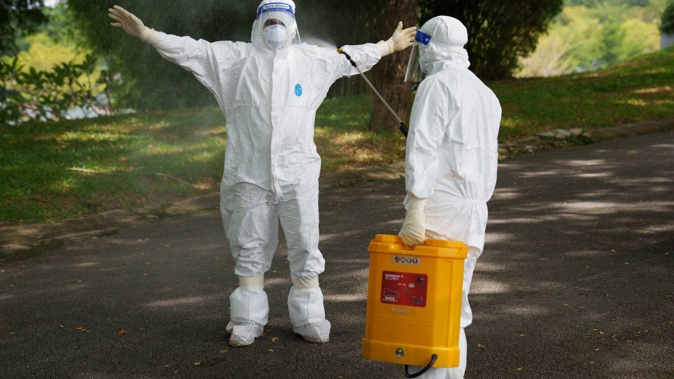
When the coronavirus pandemic first emerged in Wuhan, China in December 2019, conspiracy theorists quickly pointed out that it was close to the Wuhan Institute of Virology, a leading world centre for research on coronaviruses.
Of all the labs in all the cities in all the world, a deadly coronavirus had emerged at the spot where scientists were believed to be creating deadly coronaviruses.
Yet within a matter of weeks, vocal members of the scientific community had roundly ridiculed the claims, criticising "shoddy" research that had spread on social media. It was far more likely, they insisted, that the virus had jumped from an animal and been picked up by a human in the Wuhan wet market.
Early indicators showed that many of the people who became infected early on had links to the market, and by May last year scientists had found that the virus was 97.1 per cent similar to a disease found in bats in China's Yunnan province.
So by last summer, despite the odd murmuring from the Trump administration, the lab escape theory seemed dead. Geneticists who claimed they had found evidence of man-made inserts in the virus were shunned, and journals refused to publish their work.
Yet in recent weeks, eminent scientists have been raising their heads above the parapet to insist the theory cannot be ruled out.
In a letter to the journal Science earlier this month, 18 of the world's top epidemiologists and geneticists from institutions including Cambridge, Harvard and Stanford called for an independent inquiry.
Crucially, one of the authors was Professor Ralph Baric, of the University of North Carolina at Chapel Hill, who has worked with Shi Zheng-li of the Wuhan Institute of Virology, enhancing bat viruses so they can infect humans.
Professor Erik van Nimwegen, from the University of Basel and one of the signatories of the Science letter, told The Telegraph: "Reports may have created the impression that there is a consensus in the scientific community that the possibility that Sars-Cov2 leaked from a laboratory can be safely dismissed.
"However, there is no solid scientific basis for such dismissal. Almost a year and a half after the outbreak, there is still essentially no direct evidence available either for zoonotic spillover or for a lab leak.
"Moreover, the latter possibility has hardly been investigated at all – not in the least because relevant information has simply not been made available to the international scientific community."
It also emerged that a letter in the Lancet last February "strongly condemning" the lab escape theory had been organised by Peter Daszak, the president of the EcoHealth Alliance, which funded coronavirus research at the Wuhan Institute of Virology.
Zoonosis v lab escape
Increasingly, some scientists now believe lab escape may actually be a simpler solution than the virus jumping from a bat, particularly as the infected bat population – or intermediary host – have never been found despite huge efforts.
One of the major problems with the zoonosis – bat jumping – theory was that coronavirus turned up oddly well adapted to infect the human upper respiratory tract. But if a virus had been altered to specifically infect humans it would make more sense, some argue.
A new unpublished research paper, seen by The Telegraph, shows that scientists were doing just that as early as 2008. The tests, known as "gain of function" experiments, were designed to get ahead of an emerging deadly virus.
In 2008, Dr Shi's group in Wuhan first demonstrated the ability to switch the receptor binding domains for bat and human Sars viruses, and by 2010 the Institute of Virology had embarked on "gain of function" experiments to increase the infectiousness of Sars coronavirus in humans.
By 2015, Wuhan scientists had created a highly infectious chimeric virus which targeted the human upper respiratory tract.
In 2018 and 2019, grants from the National Institute of Allergy and Infectious Diseases (NIAID) in the US show that Shi had applied to work on "virus infection experiments in humanised mice" using Sars coronaviruses to find out what changes could lead to a spillover event into humans.
Shortly before the first cases of coronavirus were reported, Daszak gave an interview, saying the work had been going on for six or seven years, and warning that they had created "untreatable" Sars viruses which could infect humanised mice.
"You can't vaccinate against them," he said. "So these are a clear and present danger."
In the new paper, scientists also point out that the spike protein of Sars-Cov2 – which the virus uses to enter cells – has changes on the surface which would fit with manipulation through "gain of function" experiments, where high infection is the goal.
The authors of the new work say the chimeric experiments in 2015 were also found to impact sweet and bitter taste receptors and could account for why people lose their sense of taste during Covid.
They even speculate that because the groups used cell lines from Henrietta Lacks – the African-American woman whose cancer cells are the source of the first immortalised human cell line – it may have enabled the virus to become more infectious to black populations.
The paper concludes that several features in coronavirus are "unlikely to be the result of natural evolution" and, taken together, point to "purposive manipulation, specifically for gain of function".
Others are less sure. Dr Jonathan Stoye, group leader of the Retrovirus-Host Interactions Laboratory at The Francis Crick Institute, believes the fast evolution of the virus makes a man-made explanation unlikely.
"It seems extremely improbable, perhaps impossible, that changes spanning such an evolutionary distance could have occurred during virus growth in a lab," he said.
"It therefore remains most likely that the immediate ancestor to SARS-CoV-2 exists in the wild and is still to be found."
Previous lab leaks
Yet one thing is certain. Lab leaks have occurred many times before. In 2004, the Sars virus escaped from a high-containment research lab in Beijing at least three times, causing local outbreaks.
Earlier this week, a US intelligence report identified three researchers at a Wuhan lab who sought treatment at a hospital after falling ill in November 2019. A report last May suggested there may have been an emergency shutdown at the Wuhan Institute of Virology as early as October.
US President Joe Biden has now given intelligence services three months to report on the origins of Covid – but it will rely on China being more open, and that is looking unlikely.
For now, all we have is a smoking gun, an eye-watering death rate – and an unsettling feeling that there is more to this virus than meets the eye.
Take your Radio, Podcasts and Music with you









